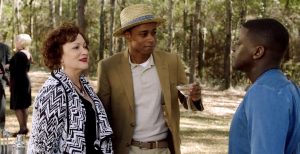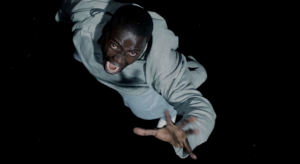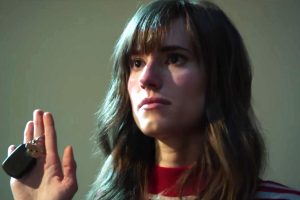In the media, racism is either non-existent or intensely focused upon. In the case of Hidden Figures, a movie about three black women, Katherine Johnson, Mary Jackson, and Dorothy Vaughan, who struggle to prove themselves in the segregated and male-dominated world at NASA, it leans toward the middle of the two. This middle-ground is a trend that is even seen with recent shows like 2 Dope Queens, a show meant to highlight the talents of those from diverse backgrounds. However, this show falls flat in establishing its desired message, which also occurs in Hidden Figures despite both discussing or showing controversial issues. While Hidden Figures excels at getting the message of racism across, it restricts the conversation it can have on the topic and thus limits the impact of its message because similar to shows like 2 Dope Queens, it resorts to nonconfrontational tones and supporting characters that act as a crutch to the stars true success in order to pander to a wider audience.
Altering a narrative in order to connect to a wider audience isn’t new. It’s been seen in books like Uncle Tom’s Cabin and even more recently with HBO’s special 2 Dope Queens. Uncle Tom’s Cabin was a book written by a white woman that portrayed a tamer side to slavery and ended with the main character, Uncle Tom, gaining freedom through death. Despite causing feelings of indignation and anger from the black community, the white community responded strongly to the story. That’s because in order to get the white public to resonate with the message the author had to create characters that they could empathize with while not feeling like they were being attacked for the institution of slavery. A similar mentality is still prevalent as seen with 2 Dope Queens which premiered on HBO in February of this year.
2 Dope Queens is hosted by two black, female comedians, Jessica Williams and Phoebe Robinson, who invite various guests and comedians onto the show. This show is based on their podcast, of the same name, which focused on promoting comedians and people of diverse backgrounds, such as people of color, females, and those of the LGBT community. However, the show does not fully embrace the original purpose of their podcast and in the first episode, only two of the five comedians were of color, and only one was female. Despite their podcast having a history of success, a lot of major companies are still afraid to solely rely on the success of minorities and resort to using white actors/comedians/etc. as a way to guarantee some form of revenue. Plus, since the show now includes a bigger and whiter audience, they don’t want to make it feel as though they are excluding them from the narrative. In addition, they steer away from controversial topics since as a new show they don’t want to polarize people. This is what causes them to play it safe and include comedy that is neutral and easy to laugh at but doesn’t necessarily make a statement. When they do include a female comedian, who does a routine that discusses some controversial topics they make her go first so as to follow her up with routines that are “safer” so they can end on a positive and non-confrontational note. Ending with a “happy-ending” makes it so people come back to watch again. However, this isn’t the only tactic they use to get people to stay and watch, they also have a well-known celebrity join them, to add credit to their show and entice people to watch. For the first episode, they use Jon Stewart, even making sure to include his name in the synopsis of the episode. Not only is he used to gain more viewers, he also acts as a way to legitimize their comedy, because if a famous comedian supports your show then it must mean it’s good. However, in doing so they are using someone else’s fame to help support their goals instead of relying on their own humor and talent. Relying on someone else is a trap that is easy to fall into. People make it seem like you aren’t good enough the way that you are, so you change yourself or rely on others to make yourself “better”, but in doing so you lose that originality and feature or message that defined you. 2 Dope Queens gave up the amount of impact their message about diversity would have in order to be successful in the eyes of the public and the company. Unfortunately, Hidden Figures is guilty of the same issues.
While Hollywood has more recently begun to trust that a story focused on minorities can and will make money, as seen with such hits as Black Panther and Get Out, at the release of Hidden Figures, Hollywood was still hesitant about giving the story entirely to three black characters. As such, they resort to lessening the impact of segregation and racism during the 1960s and also include a white male figure who acts as a hero and takes some of the focus from the women’s stories, losing some of the message’s impact, just as Jon Stewart did for 2 Dope Queens. This is seen most prominently with Al Harrison, Kevin Costner, Katherine’s boss. They could have given the narrative completely to Katherine and watched as she climbed the ranks and proves herself to her colleagues by her own efforts. Which they do to a point, but they also use supporting characters like Harrison and John Glen, to shoulder some of her burden and aid in her success, making it seem like she couldn’t have succeeded on her own. There is no reason for them to have these male supporting leads provide such a pivotal role to Katherine’s success, especially when they have characters like the Polish engineer who gives Mary the idea that it is possible to become an engineer as a colored woman. But it is Mary herself who determines her own success. She is the one who takes the matters into her own hands and goes to court to defend her position. Even with Mary’s future depending on the decision of a white male judge, he isn’t acting as a crutch that is needed to help her succeed, he instead functions as a roadblock that Mary must overcome. With Katherine, that’s not the case, because Harrison is very likable, understanding, and is seen as caring for the mission more than the differences in a person’s skin color. Basically, Harrison is an idealized character. Which is the other problem the movie has that lessens the film’s impact: resolving all the conflicts and ignoring the reality of America during that time.
As the movie strives to be a feel-good movie, it aims to end on a happy note to get more people to like the movie, again relying on tactics and tropes instead of letting the character’s story speak for itself. The three women accomplish a lot and it’s an amazing success story by itself, but by the end the movie decides to make it seem like people are no longer racist and segregation is no longer a reality, despite it taking several more years for blacks to gain full rights. In one scene, as John Glen is hurtling back to earth, it makes a point to show all these people from different walks of life standing together with a common hope, not looking at their differences but being brought together by the fact that they are all Americans. This is even more obvious when it contrasts with the various scenes in the movie where it explicitly shows only black families watching the TV together, versus those who were white watching the news somewhere else. Then after they show everyone standing together they proceed to resolve most of the conflicts. Ms. Mitchell, the white counterpart, and a roadblock to Dorothy’s success, finally gives Dorothy her rightful title of supervisor and even asks for her help in teaching her own “computers” how to program the IBM. Katherine, through the help of John Glen, gets her job at the Space Task Group back, and Mary is now a certified engineer. It’s a very idealistic ending, and while it does highlight each women’s very real achievements, it doesn’t acknowledge that segregation and racism did continue, even at NASA. As one computer programmer who reviewed the movie said, “the strange thing for me is that I saw more black programmers in this movie than I’ve ever encountered in my entire career… Even today, some of my customers look at me funny when I show up to fix the problem” (Henderson). Meaning there is still an issue with racism and explains why 2 Dope Queens was formatted the way that it was. While the movie misses the chance to really delve into the full extent of segregation, at the very least the times it does focus on it, it does it well.
Hidden Figures scenes of segregation and racism work because they not only contrast scenes of the women alone vs them at work it also emphasizes the microaggressions they face. These microaggressions are what really helps create an atmosphere of tension, and highlights how it’s the small things that can slowly eat away at a person’s patience and tolerance. Most of the examples of racism are seen through the way her colleagues look at her when she enters a room, how they don’t talk to her, or how they get her a coffee pot that says “colored” on it, or even how a white woman hurries her daughter away from a black man drinking from a colored water fountain. The movie even makes sure to highlight how the little things like going to the bathroom, getting a library book, or going to class are much harder for a person of color. When they do acknowledge the historically violent and oppressive moments of segregation, they do so subtly. A brief scene of people protesting with the police surrounding the protestors, a news program in the background, a mention in the pastor’s sermon, or a brief reference to Rosa Parks. They make sure to emphasize these scenes by either making them silent, as with the scene when Katherine first enters the Space Task Group so that you become acutely aware of the stares. Or with a burst of music that highlights the absurdness of the situations they are put in, like Katherine having to run half a mile to go to the bathroom. To emphasize the tension of racism in general, they show scenes that show both the women in the workplace and by themselves. There is an obvious personality shift that is seen between the two locations, so that when they are alone you get to see more of their personalities shine and see them smile and have fun, while at work they are polite, wary, and reserved. It just adds to the effect of how they had to be on constant alert of their situation because one wrong move wouldn’t be tolerated.
The other point they make sure to acknowledge is that racism is dynamic and might not always be obvious, especially to the person who is being racist. Ms. Mitchell, Dorothy’s “villain”, one day tells Dorothy, “Despite what you may think, I have nothing against Y’all” (Hidden Figures). With Dorothy responding, “I know, I know you probably believe that” (Hidden Figures). That scene shows us that despite Ms. Mitchell clearly being prejudiced against Dorothy she doesn’t think she herself is. It creates an interesting new dynamic for a character that at first was only a one-dimensional villain. It gives you some insight into how she views herself. Then there is Katherine’s relationship with Paul Stafford. Paul Stafford is the classic antagonist to Katherine, yet he slowly starts to accept her. He doesn’t have a complete change of heart, as it appears Ms. Mitchell does, but he does begin to grudgingly acknowledge her when she speaks. This is the one time the movie doesn’t have a perfect resolution between a character and their antagonist and shows how very often it is hard for a person to get rid of their prejudices. While they could have overall been more open and obvious about the turmoil that came with segregation, they do portray it as best they can with the limitations they have and highlight that tension and fear that each of the women faced each day.
In the end, the fact that these types of movies are being made is already a step in the right direction. However, the way the narrative is portrayed still leaves something to be desired. It still relies on old tropes like having a happy-ending where all the conflicts are resolved and using more famous actors to support the film. Despite all that, Hidden Figures has a remarkable cast that plays off each other very well and does a really good job at giving the audience a sense of what it would be like to live like and work in the segregated 1960s. Hopefully, now that movies like Black Panther have done so well, Hollywood will no longer rely on cheap tactics to get people to like the movie and instead realize that people will enjoy the story the way it is, without having to change the narrative.
Citations:
Henderson, Odie. “Hidden Figures.” Roger Ebert, 20 Dec. 2016, https://www.rogerebert.com/reviews/hidden-figures-2016. Accessed 27 Apr. 2018.
Hidden Figures. Directed by Theodore Melfi, performances by Taraji P. Henson, Octavia Spencer, Janelle Monáe, Kevin Costner, Jim Parsons, Kristen Dunst, and Glen Powell, 20thCentury Fox, 2016.
2 Dope Queens, Directed by Tig Notaro, HBO, 2018.






